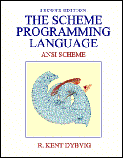
The Scheme Programming Language, Second Edition
© 1996. Electronically reproduced by permission of Prentice Hall, Upper Saddle River, New Jersey.
http://www.scheme.com
Illustrations © 1997 Jean-Pierre Hébert
to order this book
about this book
[1] Harold Abelson and Gerald J. Sussman with Julie Sussman. Structure and Interpretation of Computer Programs, second edition. MIT Press and McGraw-Hill, 1996.
[2] J. Michael Ashley and R. Kent Dybvig. An efficient implementation of multiple return values in Scheme. In Proceedings of the 1994 ACM Conference on Lisp and Functional Programming, pages 140-149, June 1994.
[3] William Briggs and Van Emden Henson. The DFT: An Owner's Manual for the Discrete Fourier Transform. Society for Industrial and Applied Mathematics, Philadelphia, 1995.
[4] William Clinger, Jonathan Rees, et al. The revised4 report on the algorithmic language Scheme. LISP Pointers, 4(3), 1991.
[5] William F. Clocksin and Christopher S. Mellish. Programming in Prolog, second edition. Springer-Verlag, 1984.
[6] Sam M. Daniel. Efficient recursive FFT implementation in Prolog. In Proceedings of the Second International Conference on the Practical Application of Prolog, pages 175-185, 1994.
[7] R. Kent Dybvig. Chez Scheme System Manual, Rev. 3.0. Cadence Research Systems, Bloomington, Indiana, December 1995.
[8] R. Kent Dybvig and Robert Hieb. Engines from continuations. Computer Languages, 14(2):109-123, 1989.
[9] R. Kent Dybvig, Robert Hieb, and Carl Bruggeman. Syntactic abstraction in Scheme. Lisp and Symbolic Computation, 5(4):295-326, 1993.
[10] Daniel P. Friedman and Matthias Felleisen. The Little Schemer, fourth edition. MIT Press, 1996.
[11] Daniel P. Friedman, Christopher T. Haynes, and Eugene E. Kohlbecker. Programming with continuations. In P. Pepper, editor, Program Transformation and Programming Environments, pages 263-274. Springer-Verlag, 1984.
[12] Christopher T. Haynes and Daniel P. Friedman. Abstracting timed preemption with engines. Computer Languages, 12(2):109-121, 1987.
[13] Christopher T. Haynes, Daniel P. Friedman, and Mitchell Wand. Obtaining coroutines with continuations. Computer Languages, 11(3/4):143-153, 1986.
[14] Robert Hieb, R. Kent Dybvig, and Carl Bruggeman. Representing control in the presence of first-class continuations. In Proceedings of the SIGPLAN '90 Conference on Programming Language Design and Implementation, pages 66-77, June 1990.
[15] IEEE Computer Society. IEEE Standard for the Scheme Programming Language, May 1991. IEEE Std 1178-1990.
[16] Brian W. Kernighan and Dennis M. Ritchie. The C Programming Language, second edition. Prentice Hall, 1988.
[17] Vincent S. Manis and James J. Little. The Schematics of Computation. Prentice Hall, 1995.
[18] Peter Naur et al. Revised report on the algorithmic language ALGOL 60. Communications of the ACM, 6(1):1-17, January 1963.
[19] David A. Plaisted. Constructs for sets, quantifiers, and rewrite rules in Lisp. Technical Report UIUCDCS-R-84-1176, University of Illinois at Urbana-Champaign Department of Computer Science, June 1984.
[20] J. A. Robinson. A machine-oriented logic based on the resolution principle. Journal of the ACM, 12(1):23-41, 1965.
[21] George Springer and Daniel P. Friedman. Scheme and the Art of Programming. MIT Press and McGraw-Hill, 1989.
[22] Guy L. Steele Jr. Common Lisp, the Language, second edition. Digital Press, 1990.
[23] Guy L. Steele Jr. and Gerald J. Sussman. The revised report on Scheme, a dialect of Lisp. MIT AI Memo 452, Massachusetts Institute of Technology, January 1978.
[24] Gerald J. Sussman and Guy L. Steele Jr. Scheme: An interpreter for extended lambda calculus. MIT AI Memo 349, Massachusetts Institute of Technology, May 1975.
[25] Mitchell Wand. Continuation-based multiprocessing. In Conference Record of the 1980 Lisp Conference, pages 19-28, August 1980.
 |
R. Kent Dybvig The Scheme Programming Language, Second Edition © 1996. Electronically reproduced by permission of Prentice Hall, Upper Saddle River, New Jersey. http://www.scheme.com Illustrations © 1997 Jean-Pierre Hébert to order this book about this book |